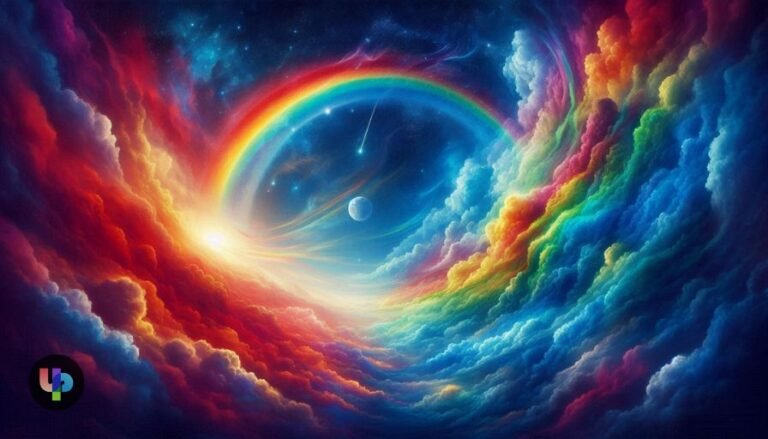Rainbows have fascinated humanity for centuries, inspiring awe and wonder with their vibrant display of colors across the sky. The keyword “Color:Ejhbt9tak_E= Rainbow” captures the idea of this natural phenomenon and its significance across various fields, from science and art to symbolism and culture. In this article, we’ll dive deep into what rainbows represent, the science behind them, and how they are incorporated into creative expressions and everyday life.
The Science Behind Rainbows
A rainbow occurs when sunlight is refracted, reflected, and dispersed through water droplets, creating a spectrum of colors in the sky. The colors typically follow this order:
- Red
- Orange
- Yellow
- Green
- Blue
- Indigo
- Violet
This natural light display is caused by a process that splits white light into its component colors. When the sunlight enters a water droplet, it bends, then reflects off the inner surface of the droplet, and finally refracts again as it exits, creating the colorful arc we recognize as a rainbow.
Symbolism of the Rainbow
Hope and Optimism
Rainbows often symbolize hope, optimism, and the promise of a brighter future. This association comes from ancient stories where rainbows were seen as divine signs or symbols of peace after a storm. In some cultures, the rainbow is considered a bridge between earth and heaven, adding to its mystical and hopeful nature.
Diversity and Inclusion
In modern contexts, the rainbow has become a symbol of diversity, particularly with the LGBTQ+ community. The rainbow flag, designed by Gilbert Baker in 1978, represents the variety and inclusivity of different identities within the LGBTQ+ spectrum. Each color in the flag has its own meaning:
- Red: Life
- Orange: Healing
- Yellow: Sunlight
- Green: Nature
- Blue: Serenity
- Violet: Spirit
This usage of the rainbow showcases its powerful role in representing acceptance and pride.
Beauty and Wonder
Rainbows also embody beauty, wonder, and the magical side of nature. The ephemeral quality of a rainbow, appearing after a rainstorm and lasting for only a short while, adds to its charm. Its vibrant colors can inspire creativity and artistic expression, symbolizing the full spectrum of life’s experiences.
Rainbows in Art and Design
Using the Color:Ejhbt9tak_E= Rainbow in Art
Rainbows are frequently used in art to convey joy, harmony, and balance. The combination of colors allows artists to play with vibrancy and contrast, offering a dynamic palette to work with. In paintings, rainbows often serve as metaphors for renewal or serve as bridges between different elements in the artwork.
Moreover, the rainbow is not just limited to traditional visual arts. It appears in digital design, fashion, and even architecture. Designers incorporate the rainbow to evoke positivity or playfulness in their work, using it as a way to attract attention and elicit emotional responses from viewers.
Rainbow in Digital Media
In the digital realm, the keyword “Color:Ejhbt9tak_E= Rainbow” signifies the use of gradient colors in user interfaces, logos, and marketing materials. Gradients—where colors seamlessly blend into each other—are a popular way to create modern, sleek designs. Brands and designers use rainbow gradients to symbolize innovation, inclusivity, and creativity, helping them stand out in competitive spaces.
The Rainbow in Popular Culture
Music and Film
Rainbows have long been part of popular culture. One of the most famous examples is the song “Somewhere Over the Rainbow” from The Wizard of Oz, which uses the rainbow as a metaphor for hope and dreams of a better life. In films, rainbows often serve as visual metaphors for transitions, bridging the gap between different worlds or realities.
Rainbows in Children’s Media
In children’s books, TV shows, and movies, rainbows are often portrayed as magical, offering paths to other realms or treasures. They capture the imagination of children, symbolizing a world full of possibilities and adventure. Animated movies often use rainbows to evoke joy and wonder, reinforcing positive messages for younger audiences.
Incorporating Rainbow Colors in Your Everyday Life
Interior Design
The vibrant and diverse palette of a rainbow can bring energy and life into interior spaces. Designers use rainbow colors to create lively environments in children’s rooms, creative studios, or even workspaces that aim to foster creativity. Accent pieces like rugs, pillows, or artwork featuring rainbow patterns can brighten any room.
Fashion
In fashion, rainbow prints and patterns are often used to make bold statements. From casual wear to runway collections, the use of rainbow colors can represent individuality, positivity, and boldness. Wearing rainbow-colored clothing or accessories is also a way to make a visual statement of inclusivity and pride.
Conclusion
The keyword “Color:Ejhbt9tak_E= Rainbow” symbolizes more than just a natural phenomenon. Rainbows have become a powerful representation of diversity, hope, beauty, and creative expression. Whether it’s through their scientific marvel, cultural significance, or artistic applications, rainbows continue to inspire and captivate people around the world.
